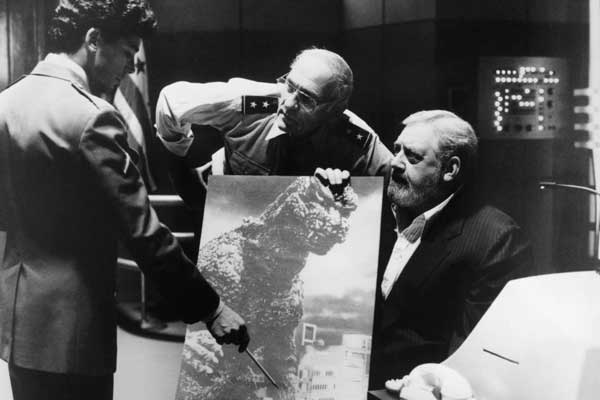In 1954, Japanese studio Toho, released Gojira, a copy of America's Beast From 20,000 fathoms, remade with political and strong anti-nuclear overtones. It quickly became the most attended, highest-grossing release in Japanese film history.
The uncut film in Japanese found a limited release in the USA, almost exclusively in Japanese neighborhoods. In 1956, American producer Joseph E. Levine paid Toho $25,000 for the American rights to distribute Gojira. Gojira was a made-up word with no English equivalent, so Levine sounded it out phonetically and came up with "Godzilla."
Afraid American audiences wouldn't appreciate the film's political overtones, Levine trimmed out almost twenty minutes. He then injected scenes shot in Los Angeles with American actor Raymond Burr with body doubles of Japanese characters in the original footage to try and match the existing Japanese footage. He randomly picked Steve Martin's name for Burr's character many years before the banjo-playing comedian became famous for his song "King Tut".
Adding the subtitle "King Of The Monsters", Godzilla was released to American Audiences in 1956 to the same baby boomer, drive-in audiences that fueled the 50's sci-fi craze and rivaled the success of many home-grown films.
The original Japanese version was hard to come by in the US. As monster obsessed as I was, I never saw it myself until bootleg versions became available on VHS in the 90s.
In 1957, CBS hired Burr to play Perry Mason, one year after Godzilla King Of The Monsters. Mason was a pulp novel character featured in over eighty novels beginning in the 1930s. He appeared in films and radio with other actors before television.
Perry Mason flipped the typical pulp novel detective formula by making the title character a defense lawyer rather than a policeman or a private eye. Perry Mason never really defended anyone as we know it. His clients were never guilty. He used detective skills rivaling Hercule Poirot and invariably proved his clients never committed the crimes they were accused of. Often he exposed the true culprit in the courtroom itself!
Burr's original run as Perry Mason ran from 1957 to 1966, revived in the seventies, and several made-for-tv movies in the eighties. Burr was tall, steely-eyed, and wore impossibly angular suits. He had the looks of a matinee hero, and he was also quite gay, in a time when American men were being arrested just for being gay.
Burr had a short-lived, studio-arranged marriage to a woman he hardly met. Following that, he simply lied and made up two more wives, both of which he invented melodramatic deaths for, making him a grieving widower in the public's eye.
Burr's actual life partner was actor Robert Benevides. They were together from 1960 until Burr's death in 1993. Benevides was not a terribly successful contract actor who had small parts in The Outer Limits and The Monster That Challenged The World. He gave up acting to do production work on Burr's projects, including executive producer of all the Perry Mason TV movies.
After 1975's Terror Of Mecha Godzilla, the fifteenth Gojira film, Toho Studios put the character in abeyance for nine years. In 1984, Toho considered reviving the character for its thirtieth anniversary. Koji Hashimoto took over the reins as director, with the working title: Gojira Returns. Hashimoto took the bold step of making his film a direct sequel to the 1954 original, ignoring all the intervening fifteen films.
Roger Corman's New World Pictures purchased the rights to distribute Gojira Returns in the US. Renamed Godzilla 1985, they again reached out to Raymond Burr to shoot American sequences to cut into the Japanese footage. Burr was delighted to comply, expressing a fondness for the monster. In the thirty years since Godzilla King of The Monsters, comedian Steve Martin became a star, so Burr's character was renamed just Mr. Martin.
Corman negotiated a deal with Dr. Pepper for product placement in the American shots. Burr refused to comply, so another actor was shot constantly holding a Dr. Pepper can. Burr's scenes took a little over a day to shoot. He reportedly wrote Godzilla's epilogue himself.
Gojira Returns gave new life to the series and new Japanese and American Godzilla films continue to this day. Perry Mason returns to television without Burr and both franchises thrive into the twenty-first century.


.jpg)


